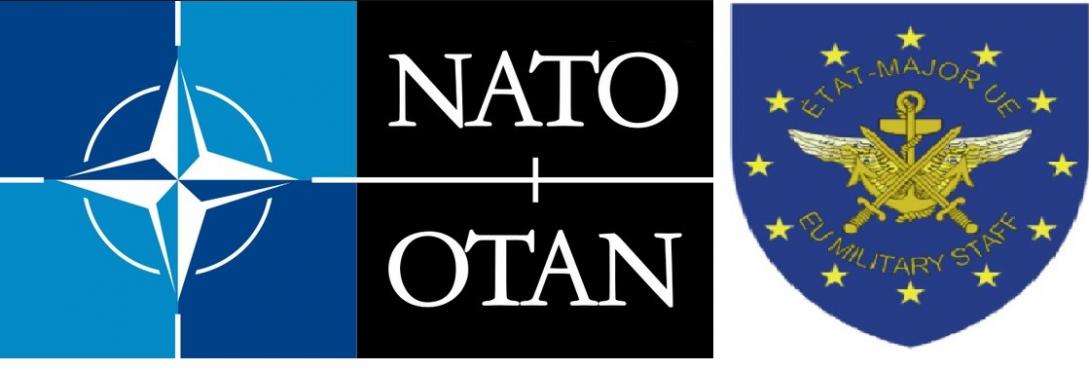NATO AND EU, STRENGTH IN COMPLEMENTARITY

Built on a foundation of common interests and challenges, the NATO-EU cooperation has grown into a strong and mutually beneficial partnership. Initiated in the 1990s, this relationship was institutionalised over a decade later with the 2002 NATO-EU Declaration on European Security and Defence Policy. This milestone set out common political principles and reaffirmed the EU’s access to NATO’s planning capabilities for its own military operations. To this day, one of the key tenants of the EU-NATO cooperation remains the single set of forces. This means that common members should not have two sets of capability requirements, but only a single set of forces for both. Therefore, efficiency must be ensured and duplication avoided.

Each subsequent NATO summit has further enriched this cooperation. At the 2010 Lisbon Summit, the NATO Allies approved the Strategic Concept, which, amongst others, committed the Alliance to working more closely with other international organisations, such as the EU, to prevent crises, manage conflicts and stabilise post-conflict situations. In Warsaw in July 2016, the two organisations outlined areas for strengthened cooperation in light of the common emerging security threats to the east and south, including countering hybrid threats, enhancing resilience, defence capacity building, cyber defence, maritime security and exercises. Two years later, in Brussels, both institutions agreed, through a joint declaration, to focus on areas such as military mobility, counter-terrorism and strengthening resilience to chemical, biological, radiological and nuclear-related risks as well as promoting the women, peace and security agenda. Today, this cooperation includes 74 projects to promote European security, capacity building, crisis management and training.

Bridging the gap between NATO and the EU has been an important element in the development of an international comprehensive approach to crisis management, especially for the COVID-19 crisis, which has required the effective application of both military and civilian means. This crisis has shown the key role that the militaries play in support of national civilian efforts, and the importance of NATO mechanisms to coordinate assistance. Across the Alliance and the EU, national armed forces have been supporting the civilian response, deploying military medics to assist over-run civilian facilities, constructing almost 100 field hospitals, evacuating patients as well as repatriating citizens, securing borders and helping with testing and transport of medical supplies. The pandemic has seen the largest peacetime military deployment in history.
The pandemic also reiterated the requirement for coordination in the medical sector, especially between civilian and military entities. Established in 2019, the Multinational Medical Coordination Centre/European Medical Command (MMCC/EMC) builds bridges between civilian and military medical experts and stakeholders – from NATO, the EU and their respective nations – to increase their medical interoperability and their operational readiness. This complements the efforts by NATO and EU staffs to exchange information, regularly, on the work to support NATO Allies and partners. Staff from NATO’s Euro-Atlantic Disaster Response Coordination Centre (EADRCC) have remained in close contact with the EU’s Directorate-General for European Civil Protection and Humanitarian Aid Operations (DG ECHO) and with the its Emergency Response Coordination Centre (ERCC). This has ensured that all activities remain coherent, complementary and transparent.
Last year, NATO also established a trust fund for the purchase of urgently needed items, and a stockpile of medical supplies. To date, sixteen NATO Allies have made financial contributions to the NATO Pandemic Response Trust Fund, including Albania, Belgium, the Czech Republic, Denmark, Germany, Iceland, Italy, Lithuania, Luxembourg, the Netherlands, North Macedonia, Norway, Slovakia, Turkey, the United Kingdom and the United States. Some NATO Allies have benefitted from the trust fund, for example, Albania, Czech Republic, Montenegro and North Macedonia have also received more than 1.5 million euros in medical supplies. More than half of the receiving Nations are also EU Members, demonstrating that support provided by NATO also lightens the burden of responsibility for the EU.

Additionally, since last April, the Rapid Air Mobility initiative has facilitated hundreds of NATO flights to deliver critical supplies around the world. Allied aircraft on relief flights now use a NATO Call Sign, and receive priority handling by Air Traffic Control in Europe. This was made possible thanks to close cooperation with EUROCONTROL, which handles the flow of all air traffic over Europe. Besides having contributed to a rapid and substantial force mobilisation in responding to the virus, NATO has upheld its military readiness. From its battlegroups in the east of the Alliance to its missions in Kosovo, Iraq and Afghanistan, NATO’s enduring commitment to peace and security has not wavered. Securing its deterrence and defence posture, benefits not only NATO Allies but the wider Euro-Atlantic region as well.
Work previously initiated, between NATO and the EU, on countering disinformation has come into sharp focus in the last year during this pandemic, as state and non-state actors attempt to exploit the COVID-19 crisis. Both organisations and their members have been actively targeted by malicious sources trying to sow divisions and undermine democracies Therefore, NATO and the EU have been working closely and diligently with all Allies and partners to identify, monitor and expose disinformation by sharing information and insight. In times of crisis, the truth and conveying accurate information to the public can save lives.
This cooperation extends across most operational domains. As NATO marks the fifth anniversary of its enhanced Forward Presence in Lithuania, Latvia, Estonia, and Poland, – the embodiment of reliable deterrence and defence – the ongoing work between the two institutions on military mobility has been essential. Through legislative measures, the simplification of procedures and diplomatic clearances to enable rapid crossing of borders, on land, in the air, and at sea, NATO has been able to improve the readiness of its forces, as well as increase their ability to move within Europe, in peacetime, crisis or conflict.
Besides boosting its own military posture from the Baltic Sea to the Black Sea, NATO has also been supporting the EU’s maritime activities. In the Aegean, the Alliance has been actively supporting efforts to reduce human trafficking and illegal migration. NATO ships are providing real-time information to the coastguards and relevant national authorities of Greece and Turkey, as well as to the EU’s Frontex operation, helping them in their efforts to tackle this crisis.
Our cooperation has also taken to the skies. Other than, the recent NATO Call Sign established during the pandemic, NATO and the EU have joined forces on a number of projects. The most notable must be the establishment of the Multi Role Tanker Transport Capability (MRTT-C). Set up by 6 NATO Allies – Belgium, the Czech Republic, Germany, Luxembourg, the Netherlands and Norway – all EU Members, with the exception of Norway, the MRTT-C project has enabled these nations to pool their resources and collectively acquire an Airbus A330 Multi Role Tanker Transport aircraft as well as establish a multinationally owned and operated fleet of MRTTs. This is another prime example in avoiding duplication and maximizing resources.
In the cyber domain, NATO and the EU are cooperating through a Technical Arrangement on Cyber Defence. In light of common challenges, they are strengthening their cooperation, notably in the areas of information exchange, training, research and exercises. For example, in 2019, the NATO Secretary General attended CYBRID, an EU hybrid exercise in Estonia, while EU representatives took part in NATO’s annual exercises such as CMX and cyber coalition. Parallel and coordinated exercises help NATO and the EU improve their knowledge of each other’s working methods and their ability to coordinate. Furthermore, the NATO and EU cyber incident response teams exchange policy updates and best practices.
Space is the youngest of NATO’s operational domain. While both NATO and the EU have been exploring its potential and defence individually, cooperation remains limited at this stage. Considering that, of the around 2,400 satellites in Earth’s orbit - 60% of which belong to NATO countries or companies located in the Alliance’s territory – synergies in this domain seem inevitable.
So for the last 30 years, this partnership has flourished, promoting peace, security, economic stability while avoiding duplication. This is partly due to a better understanding of the role of each organisation but also because there has been a flexibility to adapt and evolve. In an attempt to improve on the delivery of their respective missions, both NATO and the EU have undertaken a process of self-examination to ensure they remain fit for purpose. For NATO, it takes the form of the NATO 2030 process, which aims to provide a more integrated approach to resilience, more investment in technology, closer partnerships, and address the security implications of climate change. For the EU, the Strategic Compass will strengthen common European security, by defining future threats, goals and ambitions in defence. But most of all it is an opportunity to align and expand our ambitions for the NATO-EU cooperation, to look to the future together and develop a common understanding of the challenges and opportunities that we face.





